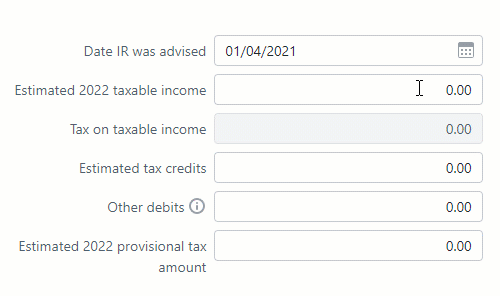- Created by KimP, last modified by MartinW on Sep 17, 2021
You are viewing an old version of this page. View the current version.
Compare with Current View Page History
« Previous Version 76 Next »
https://help.myob.com/wiki/x/oYclB
How satisfied are you with our online help?*
Just these help pages, not phone support or the product itself
Why did you give this rating?
Anything else you want to tell us about the help?
Do not delete this page - MYOB Practice navigates to it from within the product
New Zealand only
We'll soon be adding information about changes to provisional tax notices that will help you capture MYOB transactions!
The fields in the provisional basis section of the tax notice change depending on the provisional tax option being used. This is determined by the provisional tax option that was selected in the client's tax notice settings before the tax notice was created.
If you weren't able to make changes to the provisional tax option for the current period before the tax notice was created, don't worry, you can make changes within the tax notice.
Provisional basis
You can use the Estimation or Standard method to calculate provisional tax for your client.
AIM and Ratio methods will be available in a future release.
If you're using the Estimation method to calculate your client's provisional tax liability, you can enter their estimated taxable income for the year and we'll calculate their tax on taxable income and estimated provisional tax amount. Enter the other debits (individual entity types only) and estimated tax credits, and the amount is automatically adjusted. Other debits (individual entity types only) is where you enter data about portfolio investment entity (PIE) debit and non-resident withholding tax debit.

If you're using the Standard method, we automatically select the last financial year as the basis year. If the tax return for the last financial year hasn't been filed yet, the basis year will default to the year prior, provided there is tax return data for the prior year.
You can, however, change the basis year back to the last financial year. If there's no tax return data for the selected basis year, the tax notice will be pre-filled using Inland Revenue assessment data, if available.
If none of the above data is available, you can enter the other debits (individual entity types only), taxable income, tax credits fields, and we'll automatically calculate the Tax on taxable income and Residual income tax. Other debits (individual entity types only) is where you enter data about portfolio investment entity (PIE) debit and non-resident withholding tax debit.

Payable amount
The payable amount shows how the provisional tax instalment amount is calculated.
It adds the uplift from basis year to arrive at the total provisional tax amount for the year, before adding any payments and transfers made to Inland Revenue up until the instalment's due date. This helps you offset any underpayments or overpayments from previous instalments.
If the previous instalment amount was tax pooled, the pooled amount will be displayed at payments and transfers, and will be called out as being tax pooled.

Tax pooling
Tax pooling is only available to taxpayers using the Standard or Estimation options to calculate provisional tax.
To apply tax pooling to a tax notice, open the provisional tax instalment and select Yes to the question Will this instalment be tax pooled?
If there's an MYOB transaction for the expected provisional tax payment in Data reconciliation, we'll reverse it, so the provisional tax payable won't carry forward to the next tax notice.

Voluntary adjustment
You have up to 5 voluntary adjustments for individual entities, and up to 3 for all other entity types.
If you want your client to pay less tax than the instalment amount, you can make a negative voluntary adjustment by selecting the tax type, INC.
- Answer Yes to the question Do you want to make a voluntary payment?
- Select a Tax type:
- FAM—Working for families
- FBT—Fringe benefits tax
- GST—Goods and services tax
- INC—Income tax
- SLS—Student loan
Enter the voluntary adjustment amount.
If you've selected the tax type FAM, FBT, GST or SLS, you must enter a positive number.
- To add an additional voluntary adjustment, click Add another voluntary adjustment.

- To add a voluntary adjustment to a tax notice, answer Yes to the question Do you want to make a voluntary payment?.
- In the Tax type dropdown, select INC - Income.
- In the Total voluntary adjustment amount field, enter a negative amount.

The Tax notice summary fields update automatically. The negative voluntary adjustment amount appears in brackets and reduces the amount payable.


 Yes
Yes
 No
No
 Thanks for your feedback.
Thanks for your feedback.